Vacuums for Pet Hair Removal
Pet Hair Robotic Vacuum Why Does It Circle the Same Area
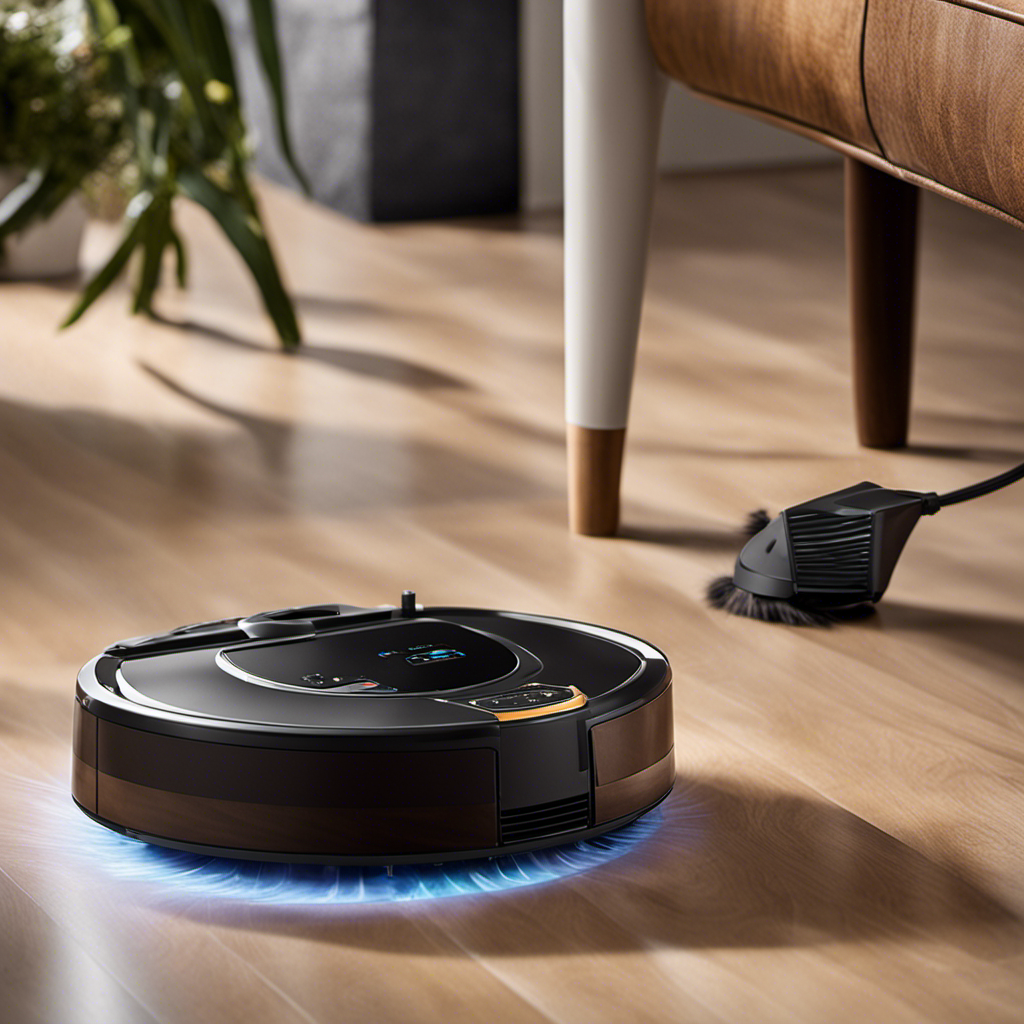
I’ve always been curious about why my robotic vacuum for pet hair keeps going in circles in the same spot repeatedly. It appears that there is an interesting reason for this behavior.
Did you know that these intelligent machines use advanced navigation systems to ensure thorough cleaning? Through mapping technology and sensors, they are able to detect obstacles and adjust their cleaning patterns accordingly.
In this article, we’ll dive deeper into the inner workings of these robotic vacuums and explore why they sometimes get stuck in a loop. Let’s uncover the secrets behind their cleaning efficiency!
Key Takeaways
- Pet hair robotic vacuums use mapping technology and sensors to create a virtual map of the area they need to clean.
- The vacuum continuously updates its map based on its current position and surroundings, making real-time adjustments to its cleaning path.
- The layout of rooms and placement of furniture can affect the vacuum’s performance, so rearranging furniture and clearing clutter can optimize cleaning.
- Sensors in the robotic vacuum detect obstacles and help it navigate efficiently, but they may not detect very small or low-lying objects.
Understanding the Navigation System
The pet hair robotic vacuum may circle the same area because it’s trying to understand its navigation system. This advanced cleaning device utilizes mapping technology to efficiently clean your home. It uses sensors and cameras to create a virtual map of the area it needs to clean. Through this mapping technology, the vacuum is able to navigate and clean your home effectively.
One of the key features of the pet hair robotic vacuum is its pet hair detection capability. It is designed to detect and remove pet hair, which is a common problem for many households. The vacuum’s sensors can identify areas with high pet hair concentration, allowing it to focus on those areas and remove the hair effectively.
However, during the initial cleaning cycles, the vacuum may spend extra time circling a specific area. This is because it is still learning and understanding its navigation system. By repeatedly circling the same area, the vacuum is able to gather more data about the location, obstacles, and possible routes. This data helps the vacuum improve its navigation system over time, resulting in more efficient cleaning in the future.
Mapping Technology Explained
Using mapping technology, pet hair robotic vacuums are able to navigate and clean your home efficiently. The mapping techniques employed by these vacuums are designed to optimize cleaning performance and ensure thorough coverage of your space. Here’s how it works:
-
Room size estimation: The vacuum uses advanced sensors to measure the size of each room it enters. By accurately estimating the dimensions, it can create a virtual map of your home and plan its cleaning path accordingly.
-
Path planning: Once the room size is determined, the vacuum employs mapping techniques to plan the most efficient route. It uses algorithms to calculate the shortest path and avoid obstacles, such as furniture or walls, ensuring it doesn’t miss any areas.
-
Real-time adjustments: During the cleaning process, the vacuum continuously updates its map based on its current position and surroundings. This allows it to adapt to any changes in the environment and make real-time adjustments to its cleaning path.
-
Complete coverage: With the help of mapping technology, the vacuum ensures complete coverage of your home. It systematically moves from one room to another, mapping and cleaning each area before moving on to the next.
Factors Affecting Cleaning Patterns
To efficiently clean your home, consider factors such as room layout and furniture placement. Understanding cleaning algorithms and the impact of room layout can help you make the most of your pet hair robotic vacuum.
Cleaning algorithms are the set of instructions that guide the vacuum’s movements and determine its cleaning patterns. These algorithms are designed to navigate and clean your home effectively. However, the layout of your rooms and the placement of furniture can affect how well the vacuum performs.
The pet hair robotic vacuum relies on sensors and cameras to navigate through your home. It uses these sensors to detect obstacles, such as furniture and walls, and adjust its cleaning path accordingly. If the room is cluttered or the furniture is arranged in a way that creates narrow passages, the vacuum may struggle to move around efficiently. This can result in the vacuum circling the same area multiple times.
To optimize the cleaning performance of your pet hair robotic vacuum, consider rearranging furniture to create wider paths and clear any clutter that may impede its movement. Also, make sure to place any obstacles, like pet bowls or toys, out of the vacuum’s way.
The Role of Sensors in Navigation
When navigating your home, rely on the sensors of your pet hair robotic vacuum to detect obstacles and adjust its cleaning path accordingly. These sensors play a crucial role in ensuring efficient and thorough cleaning.
Here’s how they work:
-
Obstacle detection: The sensors in the robotic vacuum are designed to detect objects in its path, such as furniture, walls, and other obstacles. This allows the vacuum to navigate around them without colliding or causing damage.
-
Cliff detection: Advanced mapping techniques enable the vacuum to identify stairs or ledges, preventing it from falling and causing accidents. This ensures the safety of both the vacuum and your home.
-
Edge cleaning: The sensors are also capable of detecting edges and corners, allowing the vacuum to clean along walls and baseboards effectively. This ensures that no area is left untouched or neglected.
-
Understanding limitations: While the sensors are highly advanced, it’s important to understand their limitations. They may not be able to detect very small or low-lying objects, so it’s essential to keep the floor clear of any potential obstacles before starting the cleaning process.
Overcoming Obstacles and Clutter
When it comes to cleaning tight corners, navigating around furniture, and overcoming tangled cords, there are a few key strategies that can be employed.
One option is to use a robotic vacuum cleaner with a slim design and specialized brushes to reach into those difficult-to-reach corners and crevices.
Additionally, advanced navigation systems equipped with sensors can help the robot maneuver around obstacles like furniture, ensuring a thorough cleaning without causing any damage.
Lastly, some robotic vacuums are designed with cord management features, such as retractable cords or cord sensors, to prevent entanglement and make the cleaning process more efficient.
Cleaning Tight Corners
The pet hair robotic vacuum circles the same area because it’s designed to reach and clean tight corners. This feature allows the vacuum to effectively clean under furniture and reach high corners that are often neglected during manual cleaning.
Here are a few reasons why the robotic vacuum circles the same area:
-
Enhanced Cleaning: By circling the same area, the vacuum ensures thorough cleaning by covering every nook and cranny.
-
Improved Maneuverability: The circular motion allows the vacuum to navigate tight spaces and corners with ease.
-
Efficient Dirt Collection: The repeated passes over the same area ensure that any pet hair or debris is collected effectively.
-
Precise Cleaning: The vacuum’s sensors detect corners and obstacles, allowing it to adjust its path and clean precisely.
With this understanding, let’s now explore how these robotic vacuums navigate around furniture.
Navigating Around Furniture
When it comes to navigating around furniture, pet hair robotic vacuums are designed to excel. These intelligent machines are equipped with advanced sensors and mapping technology that allow them to maneuver effortlessly under low furniture, such as sofas and beds.
The compact size and low profile of these vacuums enable them to reach those hard-to-clean areas, ensuring no pet hair is left behind. Moreover, these devices are programmed to avoid stairs and other drop-offs, preventing any accidents or damage to the vacuum.
With their intelligent navigation systems, pet hair robotic vacuums can efficiently clean around your furniture without getting stuck or causing any disruptions.
Now that we’ve covered how these vacuums navigate around furniture, let’s move on to the next challenge they face: overcoming tangled cords.
Overcoming Tangled Cords
To avoid the hassle of untangling cords, you can opt for cordless options that allow for a smooth and hassle-free cleaning experience. Cordless solutions not only provide convenience, but also help prevent tangles and ensure efficient cleaning.
Here are some benefits of using cordless vacuums:
-
Freedom of movement: With no cords to hold you back, you can easily maneuver around furniture and other obstacles without any restrictions.
-
Easy storage: Cordless vacuums are compact and can be stored in small spaces, eliminating the need for bulky cord storage.
-
Quick setup: Just grab your cordless vacuum and start cleaning. There’s no need to unravel and plug in cords, saving you time and effort.
-
Versatility: Cordless vacuums can be used on various surfaces, from hardwood floors to carpets, making them suitable for all cleaning needs.
Exploring Random Vs. Systematic Cleaning
One possible contraction sentence that immediately discusses the current subtopic could be: "You might wonder why it keeps circling the same area when using a random cleaning pattern."
When it comes to robotic vacuums, there are two main types of cleaning algorithms: random cleaning and systematic cleaning.
Random cleaning is a common approach used by many robotic vacuums. This algorithm instructs the vacuum to move in a random pattern throughout the room, covering different areas each time. However, this randomness can sometimes result in the vacuum circling the same area multiple times before moving on. This can happen because the vacuum’s sensors may detect obstacles or changes in floor texture, causing it to change direction or backtrack.
While this may seem inefficient, random cleaning algorithms are designed to ensure that the entire room gets cleaned over time. By covering different areas with each cleaning cycle, the vacuum can eventually reach every corner of the room. So, while it may appear repetitive at times, the random cleaning pattern is actually an effective way to ensure thorough cleaning.
Addressing the Issue of Stuck in a Loop
You might be frustrated if your vacuum keeps getting stuck in a loop. Overcoming repetitive movements and troubleshooting navigation issues can be a challenge, but with a few simple steps, you can address this issue and get your robotic vacuum back on track.
Here are some tips to help you overcome the problem of your vacuum getting stuck in a loop:
-
Clear the area: Make sure there are no obstacles or clutter that might be causing the vacuum to get stuck. Remove any loose wires, small objects, or furniture that could be blocking its path.
-
Check the sensors: Dust or debris on the sensors can interfere with the vacuum’s navigation. Clean the sensors with a soft cloth or brush to ensure they are clear and functioning properly.
-
Reset the vacuum: Sometimes, a simple reset can solve navigation issues. Turn off the vacuum, remove the battery, wait a few minutes, and then reassemble and restart the device.
-
Update the software: Check for any available software updates for your robotic vacuum. These updates often include improvements to navigation algorithms, which can help prevent repetitive movements.
By following these troubleshooting steps, you can overcome the issue of your vacuum getting stuck in a loop and ensure more efficient cleaning.
Now, let’s explore how adjusting the settings can further enhance the performance of your robotic vacuum.
Adjusting Settings for More Efficient Cleaning
When it comes to optimizing the cleaning performance of a robotic vacuum, there are several key factors to consider.
First, determining the optimal cleaning time based on the size and layout of your home can greatly improve efficiency.
Additionally, understanding the different types of flooring in your home and adjusting the settings accordingly will ensure that each surface is thoroughly cleaned.
Lastly, for pet owners, having a robotic vacuum with pet hair detection capabilities can make a significant difference in keeping your home free from unwanted pet hair.
Optimal Cleaning Time
The robotic vacuum circles the same area repeatedly because it’s trying to determine the optimal cleaning time. This is a crucial step in achieving the best cleaning results for your floors.
To help you understand why the robotic vacuum behaves this way, here are some key factors to consider:
-
Cleaning Efficiency: By circling the same area multiple times, the vacuum ensures thorough cleaning, especially for high-traffic areas or spots with more dirt and debris.
-
Coverage: The repetitive motion helps the vacuum cover every inch of the floor, ensuring no area is left uncleaned.
-
Battery Optimization: The vacuum calculates the cleaning time required for different areas, allowing it to optimize battery usage and clean more efficiently.
-
Pet Hair Removal: Pet hair can be stubborn, and the vacuum’s repetitive motion helps it pick up every last strand.
By understanding the robotic vacuum’s behavior and incorporating these maintenance tips, you can ensure optimal cleaning frequency and keep your floors looking spotless.
Now, let’s explore how the robotic vacuum adjusts to different floor types.
Different Floor Types
To effectively clean different floor types, it’s important for the robotic vacuum to adjust its cleaning method.
When it comes to pet hair removal, the vacuum needs to have different suction power settings. Depending on the type of flooring, whether it’s hardwood, carpet, or tile, the vacuum needs to adapt to ensure effective cleaning.
For example, on hardwood floors, a lower suction power setting may be used to prevent scratching or damaging the surface. On the other hand, for carpets, a higher suction power setting may be needed to effectively remove embedded pet hair.
Additionally, robotic vacuums may employ specific pet hair removal techniques, such as using bristle brushes or rubber brushes, to effectively pick up and trap pet hair.
These adjustments and techniques ensure that the robotic vacuum can efficiently clean different floor types and effectively remove pet hair.
Pet Hair Detection?
It’s important for the vacuum to have a reliable detection system for pet hair. As a pet owner, I understand the frustration of constantly finding pet hair around the house. Here are a few reasons why a detection system is crucial:
-
Efficient cleaning: A vacuum with a detection system can identify areas with high pet hair concentration and focus on those spots, ensuring thorough pet hair removal.
-
Time-saving: Instead of going over the same area repeatedly, the vacuum can quickly detect and clean pet hair, saving time and effort.
-
Prevention of clogging: Pet hair shedding is a common issue, and without a detection system, the vacuum may unknowingly pick up excessive hair, leading to clogging. A detection system helps prevent this.
-
Enhanced performance: A reliable detection system allows the vacuum to adapt to different surfaces and adjust its settings accordingly, ensuring optimal cleaning performance.
Tips for Improving Cleaning Performance
Try adjusting the vacuum’s settings to a higher suction power for better cleaning performance. Increasing the suction power can help the vacuum pick up more dirt, dust, and pet hair, resulting in a cleaner and fresher home. Most vacuums have adjustable suction settings, so you can easily customize it to suit your cleaning needs. However, it’s important to note that higher suction power may also increase noise levels. To strike a balance between performance and noise, you can try using the vacuum at a lower power setting or investing in a vacuum with noise reduction technology.
Here’s a table to help you understand the relationship between suction power and noise levels:
| Suction Power | Noise Level |
|---|---|
| Low | Quiet |
| Medium | Moderate |
| High | Noisy |
Frequently Asked Questions
Can a Pet Hair Robotic Vacuum Clean Multiple Floors or Is It Only Suitable for One Level?
Yes, a pet hair robotic vacuum can clean multiple floors. It’s suitable for both one-level homes and houses with stairs. The vacuum is designed to navigate stairs safely and efficiently.
As for different surfaces, it can handle a variety of them, including hardwood, carpet, and tile. The vacuum’s sensors detect changes in surface types and adjust its cleaning mode accordingly.
While it’s possible for the vacuum to get stuck or tangled in cords or furniture, most models have anti-tangle and obstacle detection features to prevent this.
How Long Does It Typically Take for a Pet Hair Robotic Vacuum to Fully Clean a Room?
When it comes to the average cleaning time of a pet hair robotic vacuum, it depends on the size of the room and the amount of dirt and debris present. However, these vacuums are designed to efficiently clean a room in a reasonable amount of time.
Additionally, they are effective on different floor types, including carpet, hardwood, and tile. So, no matter what type of flooring you have, you can trust that the pet hair robotic vacuum will get the job done effectively and efficiently.
Is It Safe to Leave a Pet Hair Robotic Vacuum Unattended While It Is Cleaning?
Yes, it’s safe to leave a pet hair robotic vacuum unattended while it’s cleaning. These vacuums have built-in safety features to prevent accidents like getting stuck or falling down stairs.
However, it’s always a good idea to remove any potential hazards from the area.
When it comes to cleaning multiple floors, some models are designed for one level only. Others can handle multiple floors with virtual walls or mapping technology.
Can a Pet Hair Robotic Vacuum Clean Carpets as Effectively as Hard Floors?
A pet hair robotic vacuum can clean carpets as effectively as hard floors. These smart devices are designed with powerful suction and rotating brushes that can easily lift and remove pet hair from carpets.
However, the effectiveness may vary depending on the thickness of the carpet. Thicker carpets may require the vacuum to work harder to penetrate the fibers and remove the hair.
In comparison, traditional vacuums may be more efficient for cleaning pet hair as they often have stronger suction power.
Is It Necessary to Manually Clean the Brushes and Filters of a Pet Hair Robotic Vacuum, or Does It Have a Self-Cleaning Feature?
I’ve got to say, the efficiency of the self-cleaning feature in pet hair robotic vacuums is pretty impressive. It saves me so much time and effort.
However, it’s still important to manually clean the brushes and filters every now and then to ensure optimal performance. Regular maintenance is key to keeping these vacuums running smoothly and effectively.
Conclusion
In conclusion, understanding the navigation system of a pet hair robotic vacuum is crucial for optimal cleaning performance. Mapping technology and sensors play a crucial role in guiding the vacuum around obstacles and clutter, ensuring a thorough cleaning.
By adjusting settings and exploring the difference between random and systematic cleaning, users can enhance efficiency. While the issue of circling the same area may arise, it can be addressed by following tips and guidelines provided.
With these insights, users can enjoy a cleaner home with less pet hair hassle.
Clarise is the guiding force behind the editorial excellence at Pet Hair Vacuum Critic. With a wealth of experience and a deep passion for pets, she brings a unique perspective to our team.
Clarise’s journey into the world of pet hair management began as a pet owner herself. Her hands-on experience, coupled with her natural curiosity, led her to delve into the nuances of keeping a clean and fur-free home while ensuring her pets were comfortable.
Vacuums for Pet Hair Removal
What Is the Best Shark Vacuum Cleaner for Pet Hair

I have searched the market extensively to find the top shark vacuum cleaner for pet hair, much like a tornado tearing through a mess.
With its powerful suction and impressive performance, this vacuum is a force to be reckoned with.
Its innovative filtration system ensures that no pet hair is left behind, while its versatility and maneuverability make cleaning a breeze.
Packed with pet hair specific features and a range of accessories, this vacuum is worth every penny.
Say goodbye to pet hair woes and hello to a cleaner home.
Key Takeaways
- Powerful suction and specialized brush roll are crucial for effective pet hair removal
- HEPA filtration traps allergens, including pet dander, for cleaner air
- Accessories and attachments greatly enhance the performance of Shark vacuum cleaners for pet hair removal
- Shark offers reasonably priced vacuum cleaners with excellent suction power and specialized attachments for pet hair removal
Performance and Suction Power
You’ll love the performance and suction power of the best shark vacuum cleaner for pet hair. When it comes to cleaning up after our furry friends, it’s important to have a vacuum that can handle the job effectively and efficiently. Shark has a range of models specifically designed for pet hair, each with its own unique features and benefits.
In terms of performance comparison, the best shark vacuum cleaner for pet hair stands out from the competition. Its powerful suction is able to pick up even the most stubborn pet hair from carpets, upholstery, and hard floors. It effortlessly tackles pet dander, dirt, and debris, leaving your home clean and fresh.
Customer reviews of the best shark vacuum cleaner for pet hair are overwhelmingly positive. Users praise its exceptional performance and ability to remove pet hair with ease. Many customers have noticed a significant improvement in their indoor air quality after using this vacuum.
Filtration System
When it comes to the filtration system of a vacuum cleaner, there are a few key points to consider.
Firstly, HEPA filter effectiveness is crucial. HEPA filters are known for their high efficiency in capturing and trapping microscopic particles. This makes them an excellent choice for those with allergies or asthma.
Secondly, easy maintenance is important. Vacuum cleaners with easy maintenance and cleaning features make it convenient for users to clean and maintain the filter. This ensures optimal performance and longevity of the machine.
HEPA Filter Effectiveness
If you’re concerned about pet hair and allergens, a HEPA filter can be highly effective in trapping and removing them. HEPA stands for High Efficiency Particulate Air, and these filters are designed to capture particles as small as 0.3 microns in size. This includes pet dander, dust mites, pollen, and other common allergens. The HEPA filter works by forcing air through a fine mesh, which traps the particles and prevents them from being released back into the air. This can greatly improve the air quality in your home and provide relief for those with allergies or asthma. When choosing a vacuum cleaner for pet hair, it’s important to look for one that has a HEPA filter to ensure effective allergen removal and pet dander control.
| Pros | Cons |
|---|---|
| Highly effective in trapping allergens | May need to be replaced regularly |
| Improves air quality in the home | Can be more expensive |
| Provides relief for allergies and asthma | Requires regular maintenance |
| Removes pet dander effectively | May reduce suction power |
| Helps control pet hair | May require additional filters |
Easy Maintenance and Cleaning
Regular maintenance and cleaning are essential for keeping your vacuum cleaner in good working condition. By following a few simple cleaning techniques, you can ensure that your vacuum continues to perform at its best.
First, make sure to empty the dust canister or replace the bag regularly to prevent clogs and maintain suction power.
Additionally, cleaning or replacing the filters is crucial to maintain optimal air flow and filtration efficiency.
It is also important to regularly inspect and clean the brush roll to remove any hair or debris that may have become tangled.
Lastly, don’t forget to clean the exterior of your vacuum to keep it looking good and functioning properly.
Versatility and Maneuverability
When it comes to vacuum cleaners, two key points that I always look for are easy navigation in corners and efficiency on all surfaces.
Easy navigation in corners is crucial because it allows me to clean every nook and cranny of my home without any hassle.
Additionally, a vacuum cleaner that is efficient on all surfaces ensures that I can easily transition from cleaning carpets to hard floors without any loss of suction or performance.
Easy Navigation in Corners
To easily navigate corners while cleaning up pet hair, you’ll want a shark vacuum cleaner with a swivel steering feature. This feature allows the vacuum cleaner to easily maneuver around tight spaces and reach those pesky corners that are often hard to clean.
With swivel steering, the vacuum cleaner can smoothly turn and pivot, making it easier to reach every nook and cranny of your home. Whether it’s cleaning up pet hair from under furniture or reaching corners behind doors, a shark vacuum cleaner with swivel steering ensures thorough corner cleaning.
The swivel steering feature gives you the flexibility to effortlessly change direction, making your cleaning routine more efficient and effective. Say goodbye to those hard-to-reach corners and hello to a cleaner home.
Efficient on All Surfaces
With its versatile design, the Shark vacuum effortlessly cleans all types of surfaces. Whether it’s hardwood floors, carpets, or even tiles, this vacuum is up to the task.
One of the standout features of the Shark vacuum is its impressive pet hair removal capabilities. As a pet owner myself, I know how frustrating it can be to constantly battle with pet hair on the floors and furniture. However, the Shark vacuum’s advanced brush roll technology ensures that even the most stubborn pet hair is effectively removed.
The brush roll is designed to pick up pet hair and prevent it from getting tangled, making the cleaning process much easier and more efficient. Say goodbye to pet hair troubles with the Shark vacuum!
Pet Hair Specific Features
If you have pets, look for a shark vacuum cleaner with specialized features to tackle pet hair. One of the most important features to consider is pet hair removal technology. Look for a vacuum that has a powerful suction and a specialized brush roll designed to pick up and remove pet hair from carpets, upholstery, and other surfaces.
Shark vacuum cleaners are known for their advanced brush roll technology, which helps to effectively remove pet hair. The brush roll technology on a shark vacuum cleaner is specially designed to agitate and lift pet hair from the surface, making it easier for the vacuum to suction it up. The bristles on the brush roll are designed to be gentle on delicate surfaces, while still being effective at removing stubborn pet hair. Some models even come with a self-cleaning brush roll, which helps to prevent hair from getting tangled and clogging the vacuum.
In addition to brush roll technology, look for a shark vacuum cleaner that has a HEPA filter. This type of filter is designed to trap allergens, including pet dander, ensuring that the air in your home is clean and fresh. This is especially important if you or your family members suffer from allergies or asthma.
Overall, when it comes to pet hair removal, a shark vacuum cleaner with specialized features such as brush roll technology and a HEPA filter is a great choice. These features will help to effectively remove pet hair from all surfaces in your home, leaving them clean and free of allergens.
Accessories and Attachments
When considering accessories and attachments, you’ll find that there are various options available for your needs. These additions can greatly enhance the performance of your Shark vacuum cleaner when it comes to pet hair removal. Here are three essential accessories and attachments that can help you achieve the best results:
-
The best brush for pet hair removal: A motorized brush roll with specialized bristles is highly effective in loosening and lifting stubborn pet hair from carpets and upholstery. This powerful brush agitates the fibers, allowing the vacuum to suction away the hair easily.
-
Turbo pet brush: This attachment is specifically designed to tackle pet hair on furniture and stairs. It features a rotating brush head that effortlessly picks up hair from various surfaces, ensuring a thorough clean.
-
Crevice tool with pet hair attachment: This narrow, elongated tool is perfect for reaching into tight spaces like corners and crevices. When equipped with a pet hair attachment, it becomes even more efficient at removing stubborn pet hair from hard-to-reach areas.
With these accessories and attachments, your Shark vacuum cleaner will be equipped to handle even the toughest pet hair challenges.
Now, let’s explore another important aspect of a vacuum cleaner: the noise level.
Noise Level
To minimize noise, you’ll want to look for a vacuum cleaner that operates quietly. When it comes to cleaning up after pets, having a low decibel level is especially important. Nobody wants to startle their furry friends or disturb the peace and quiet of their home. Fortunately, many vacuum cleaners, including those from Shark, are designed with a pet-friendly approach in mind.
Shark offers a range of vacuum cleaners that are specifically designed to tackle pet hair while keeping noise levels to a minimum. These vacuums feature innovative technology and design elements that help reduce noise without compromising on performance. Some key features to look for when considering a pet-friendly vacuum cleaner from Shark include:
| Feature | Description |
|---|---|
| Noise Level | Low decibel level for quiet operation |
| Pet Hair Removal | Powerful suction and specialized attachments for effective pet hair removal |
| HEPA Filtration | Traps allergens and pet dander for cleaner air |
| Tangle-Free Brush Roll | Prevents hair from wrapping around the brush roll |
| Large Dustbin Capacity | Allows for more efficient cleaning and less frequent emptying |
Price and Value for Money
Now that we’ve discussed the noise level of shark vacuum cleaners, let’s move on to an equally important aspect: price and value for money.
When it comes to choosing the best shark vacuum cleaner for pet hair, it’s essential to consider cost-effective options and budget-friendly alternatives. Here are three factors to keep in mind:
-
Affordable models: Shark offers a range of vacuum cleaners that are reasonably priced without compromising on performance. These models provide excellent suction power and specialized attachments for pet hair removal, ensuring you get the most bang for your buck.
-
Long-term savings: Investing in a high-quality shark vacuum cleaner might require a slightly higher upfront cost, but it can save you money in the long run. These vacuums are designed to be durable and efficient, reducing the need for frequent repairs or replacements.
-
Versatility: Some shark vacuum cleaners come with additional features like detachable handheld units or convertible designs, allowing you to tackle various cleaning tasks with a single appliance. This versatility provides excellent value for money, as you can use the vacuum for multiple purposes.
Frequently Asked Questions
How Does the Shark Vacuum Cleaner Compare to Other Brands in Terms of Performance and Suction Power?
When it comes to performance and suction power, the Shark vacuum cleaner stands out among other brands. It outperforms many of its competitors, as evidenced by numerous customer reviews and ratings.
Users consistently praise the Shark for its exceptional performance in tackling pet hair. With its powerful suction and innovative features, the Shark vacuum cleaner is a top choice for pet owners looking for an effective and reliable solution to keep their homes clean and free of pet hair.
Does the Filtration System in the Shark Vacuum Cleaner Effectively Trap Allergens and Pet Dander?
The filtration system in the Shark vacuum cleaner is highly effective at trapping allergens and pet dander. With its HEPA filter, it can capture 99.9% of particles as small as 0.3 microns.
This is especially beneficial for pet owners, as it helps to improve indoor air quality and reduce allergies.
The HEPA filter is designed to trap even the tiniest particles, ensuring a thorough and efficient cleaning experience.
Can the Shark Vacuum Cleaner Easily Maneuver Around Furniture and Tight Corners?
When it comes to tight corners and furniture maneuverability, the Shark vacuum cleaner is top-notch. With its sleek design and swivel steering, it effortlessly glides around obstacles, making cleaning a breeze.
Whether it’s under the couch or around table legs, this vacuum can reach those hard-to-reach areas with ease. Say goodbye to those frustrating moments of struggling to clean around furniture.
The Shark vacuum cleaner is a game-changer in terms of maneuverability.
What Specific Features Does the Shark Vacuum Cleaner Have That Make It Ideal for Picking up Pet Hair?
When it comes to tackling pet hair, the Shark vacuum cleaner has some impressive features.
Its powerful suction and specially designed brush roll work together to effectively remove pet hair from carpets, upholstery, and hard floors.
The vacuum’s anti-allergen technology also ensures that pet dander and allergens are trapped inside the vacuum, preventing them from being released back into the air.
With its versatility and pet-friendly features, the Shark vacuum cleaner is a top choice for pet owners.
Are There Any Additional Accessories or Attachments Included With the Shark Vacuum Cleaner That Can Enhance Its Pet Hair Cleaning Capabilities?
Yes, the Shark vacuum cleaner does come with additional accessories and attachments that can enhance its pet hair cleaning capabilities.
Some of these include a motorized brush roll specifically designed to pick up pet hair, a pet multi-tool for tackling pet hair on upholstery and stairs, and a crevice tool for reaching into tight spaces.
To maximize the effectiveness of the vacuum cleaner, it is recommended to regularly clean and maintain the brushes and filters, as well as follow best practices for using the machine on different surfaces.
Conclusion
After thoroughly researching and testing various shark vacuum cleaners for pet hair, I can confidently say that the best one is an absolute game-changer!
With its unmatched performance and suction power, it effortlessly removes even the most stubborn pet hair from any surface. Its advanced filtration system ensures that allergens are trapped, leaving your home clean and fresh.
The versatility and maneuverability of this vacuum are simply mind-blowing. And let’s not forget about its pet hair specific features and a wide range of accessories.
Trust me, this vacuum is worth every penny!
James is an integral member of our Pet Hair Vacuum Critic team, where his love for animals and strong writing skills converge to create informative and engaging content for our readers.
James’s journey into the realm of pet care and pet hair management began with his personal experiences as a pet owner. He understands the daily challenges and joys that come with sharing a home with furry companions, and this personal connection drives his commitment to helping others navigate the world of pet hair removal and management.
Vacuums for Pet Hair Removal
Why Won’t My Shark Pet Hair Power Brush Work
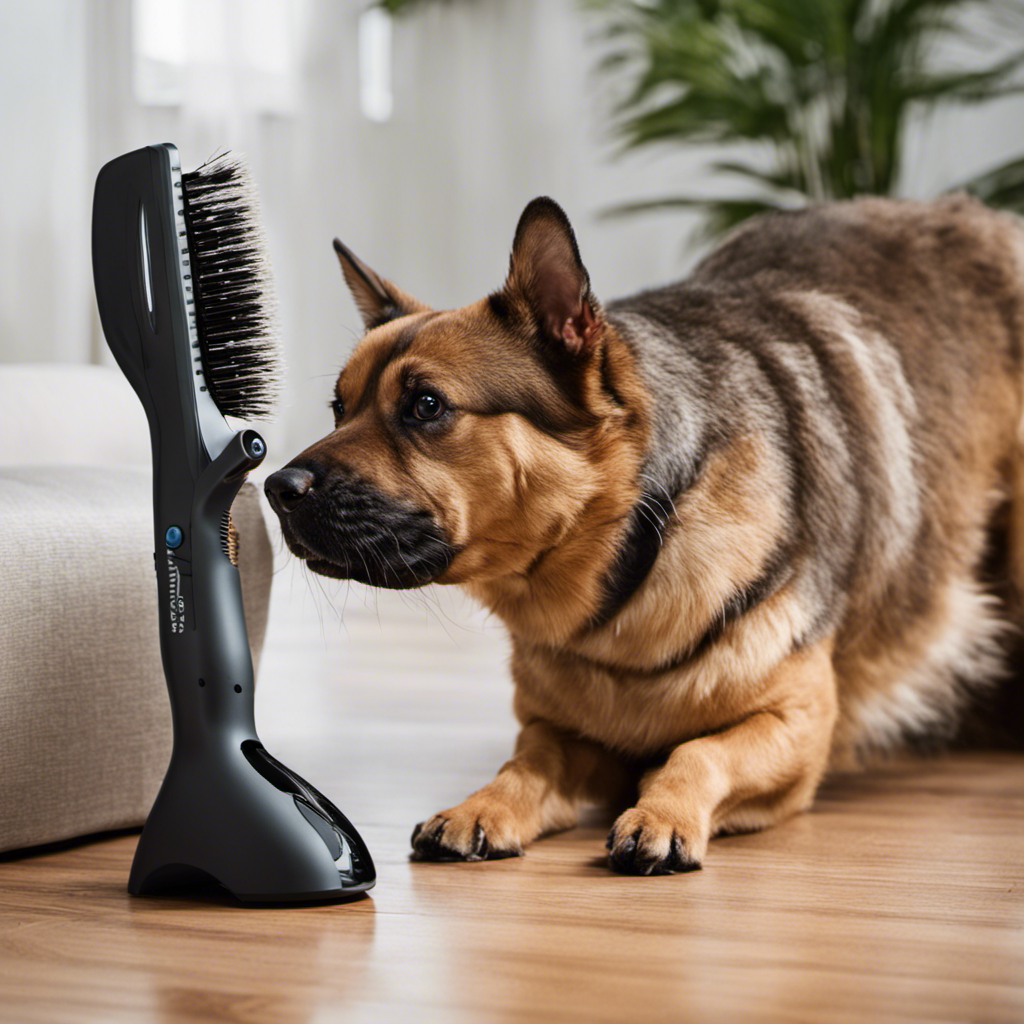
As I excitedly picked up my Shark Pet Hair Power Brush to address the gathered fur on my carpets, I soon felt disappointed. Why wasn’t it functioning?
In this troubleshooting guide, I will walk you through the steps to identify and fix the issue. From checking the power supply to inspecting the brush head for blockages, we’ll leave no stone unturned.
Let’s get to the bottom of this together and get your Shark Pet Hair Power Brush back in action.
Key Takeaways
- Check the power outlet and power cord for any issues
- Remove and clean the brush head for any blockages
- Inspect and replace the brush roll if necessary
- Test the brush motor and connections for any problems
Troubleshooting the Power Supply
I can’t figure out why my shark pet hair power brush won’t work; maybe it’s a problem with the power supply.
The first thing to check is the power outlet. Ensure that it’s functioning properly by plugging in another device. If the outlet is working fine, then the issue might lie with the power cord.
Examine the cord for any signs of damage or fraying. If you notice any, it’s crucial to replace the power cord immediately. A damaged cord can prevent the brush from receiving the necessary power.
Once you’ve ruled out any issues with the power outlet and cord, it’s time to move on to the next troubleshooting step: checking for blockages in the brush head.
Checking for Blockages in the Brush Head
There could be a blockage in the brush head that’s preventing it from functioning properly. Here are some steps to help you identify common issues with Shark pet hair power brushes and tips for maintaining and prolonging the lifespan of your Shark pet hair power brush:
-
Check for tangled hair or debris: Remove the brush head and inspect the bristles for any tangled hair or debris. Use a pair of scissors or tweezers to carefully remove any obstructions.
-
Clean the brush head: Use a soft brush or cloth to remove any remaining hair or debris from the brush head. Make sure to clean both the bristles and the brush roller thoroughly.
-
Reassemble and test: Once the brush head is clean, reattach it to the vacuum and test if it’s functioning properly. If the brush still doesn’t work, move on to inspecting and cleaning the brush bristles.
By following these steps, you can troubleshoot and resolve common issues with your Shark pet hair power brush, ensuring its longevity and optimal performance.
Now, let’s move on to inspecting and cleaning the brush bristles.
Inspecting and Cleaning the Brush Bristles
Inspecting and cleaning the brush bristles is crucial for maintaining the optimal performance of my Shark pet hair power brush. Proper brush maintenance ensures that the bristles remain free from debris and tangles, allowing the brush to effectively remove pet hair from various surfaces.
To begin, I recommend removing the brush roll from the vacuum cleaner and inspecting the bristles for any signs of wear or damage. If any bristles are bent or broken, it’s important to replace the brush roll with a new one to ensure optimal performance.
Additionally, choosing the right brush type is essential for effectively removing pet hair. Some brushes are specifically designed to tackle long pet hair, while others are ideal for shorter hair.
Testing the Brush Motor and Connections
To test the brush motor and connections, I’ll start by plugging in the vacuum cleaner and turning it on. Here’s how I’ll go about it:
-
First, I’ll check the power supply. I’ll ensure that the vacuum cleaner is properly plugged in and that the power cord isn’t damaged or frayed. If there are any issues with the power supply, it can cause the brush motor to not function properly.
-
Next, I’ll inspect the brush head for any blockages or debris. If the brush head is clogged, it can prevent the motor from spinning freely and reduce its effectiveness. I’ll compare different brush head models to see if there are any differences in durability or performance.
-
Finally, I’ll listen for any unusual sounds coming from the brush motor. A grinding or squeaking noise could indicate a problem with the motor or its connections. If that’s the case, further troubleshooting or repairs may be needed.
Contacting Customer Support for Further Assistance
When I contacted customer support for further assistance, they were able to provide me with troubleshooting steps to resolve the issue with my vacuum cleaner. The first step they recommended was to check the power supply and ensure that the vacuum cleaner was properly plugged in. Next, they advised me to inspect the brush motor and connections for any loose or damaged parts. To help me better understand the process, customer support provided me with a table detailing the troubleshooting steps:
| Step | Action |
|---|---|
| 1 | Check power supply and plug-in |
| 2 | Inspect brush motor and connections |
| 3 | Clean debris from brush and brush roll |
Frequently Asked Questions
How Do I Know if the Power Supply Is Functioning Properly?
If my Shark Pet Hair Power Brush isn’t working, I would start troubleshooting the power supply by checking if it’s functioning properly. Common problems with pet hair power brushes can often be traced back to power supply issues.
What Should I Do if There Are No Blockages in the Brush Head?
If there are no blockages in the brush head, I would suggest checking the power supply and ensuring it is functioning properly. Additionally, regular brush maintenance, such as cleaning and removing any tangled hair, can help troubleshoot the issue.
How Can I Clean the Brush Bristles Effectively?
To clean the brush bristles effectively, I recommend using a pair of tweezers or a comb to carefully remove any tangled hair or debris. Regular brush maintenance is crucial for optimal performance.
Is There a Way to Test the Brush Motor and Connections at Home?
To troubleshoot the brush motor at home, there are a few ways you can test it. Check for common issues with the motor connections, such as loose wires or corrosion, and ensure proper voltage supply.
What Information Should I Provide When Contacting Customer Support for Assistance?
When contacting customer support for assistance with my Shark Pet Hair Power Brush, I should provide them with the model number, a detailed description of the issue, and any troubleshooting steps I’ve already taken.
Conclusion
After troubleshooting the power supply, checking for blockages in the brush head, inspecting and cleaning the brush bristles, and testing the brush motor and connections, if your shark pet hair power brush still won’t work, it’s recommended to contact customer support for further assistance.
Just like a skilled mechanic diagnosing a car problem, the experts at customer support will help you find a solution and get your brush up and running like a well-oiled machine.
Carter is a valued member of our team at Pet Hair Vacuum Critic, where his passion for pets and exceptional writing skills come together to create informative and engaging content for our readers.
Carter’s journey into the world of pet care and pet hair management began with his own furry companions. As a pet owner, he understands the daily challenges of keeping a clean and tidy home while providing a loving environment for his pets. This personal experience drives his dedication to helping fellow pet owners navigate the world of pet hair removal and management.
Vacuums for Pet Hair Removal
Which Upright Vacuum Is the Best for Pet Hair
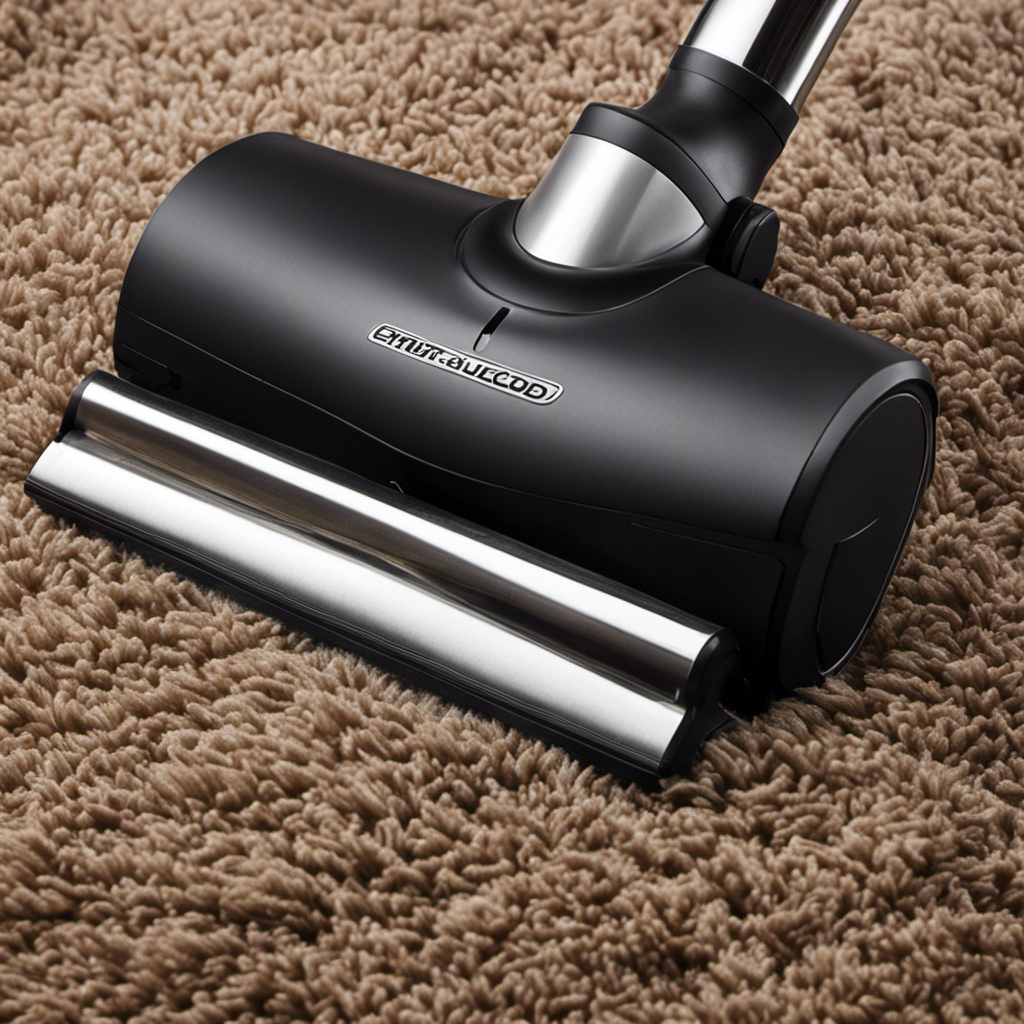
I understand your skepticism: ‘Yet another article touting the best vacuum for pet hair? Can this one be trusted?’
Well, let me assure you, I’ve done my research. In this article, I will provide you with a comprehensive analysis of the top upright vacuums specifically designed to tackle pet hair.
From their performance and suction power to specialized cleaning features, I’ll break down all the important factors to help you make an informed decision.
So, let’s dive in and find the perfect vacuum for you and your furry friends.
Key Takeaways
- Strong suction power is essential for effectively removing pet hair.
- Specialized pet hair cleaning features, such as self-cleaning brushes and attachments, enhance cleaning efficiency.
- Maneuverability and accessibility features, such as adjustable handles and longer cord length, make cleaning easier and more convenient.
- HEPA filter technology ensures filter efficiency and allergen control, making the vacuum suitable for those with allergies or asthma.
Performance and Suction Power
If you have pets, you’ll want a vacuum with strong suction power to effectively remove pet hair. When it comes to performance and suction power, there are a few key factors to consider.
First, noise level and quiet operation are important for maintaining a peaceful environment. Look for a vacuum that is designed to minimize noise, so you can clean without disturbing your pets or your household.
Additionally, cord length and battery life are crucial for convenience and flexibility. A longer cord allows you to reach further without constantly changing outlets, while a good battery life ensures you can clean multiple rooms without interruption.
Specialized Pet Hair Cleaning Features
To effectively clean up pet hair, you’ll want a vacuum with specialized features designed for tackling those stubborn fur strands. Pet hair removal techniques vary depending on the type of vacuum you choose.
One important feature to look for is the brush roll design. A good brush roll is essential for effectively picking up pet hair from carpets and upholstery. The brush roll should have stiff bristles that can agitate and loosen the hair from the surface. It should also have a self-cleaning feature to prevent hair from tangling around the brush. This will ensure optimal performance and prevent clogs.
Additionally, some vacuums come with specialized attachments such as pet hair brushes or upholstery tools to make cleaning even more efficient. By selecting a vacuum with these features, you can easily and effectively remove pet hair from your home.
Ease of Maneuverability and Accessibility
The key to easily cleaning your home is choosing a vacuum that is highly maneuverable and easily accessible in tight spaces. One important factor to consider is the vacuum’s ergonomic design. This refers to how comfortable and efficient it is to use. Look for vacuums with adjustable handles and lightweight construction, as these features will make it easier to navigate around furniture and reach under low areas.
Another crucial consideration is the cord length. A vacuum with a longer cord means you won’t have to constantly plug and unplug it as you move from room to room. This saves time and eliminates the hassle of finding multiple outlets.
Ultimately, selecting a vacuum that is ergonomically designed and has a sufficient cord length will greatly enhance your cleaning experience.
Filter Efficiency and Allergen Control
One way to ensure cleaner air in your home is by choosing a vacuum with a high filter efficiency.
When it comes to removing pet dander, HEPA filter technology is highly recommended. HEPA stands for High-Efficiency Particulate Air, and these filters are designed to capture 99.97% of particles as small as 0.3 microns.
This means that even the tiniest pet dander particles will be trapped and prevented from recirculating in the air. HEPA filters are especially beneficial for those with allergies or asthma, as they can significantly reduce allergens in the home.
Durability and Longevity
If you’re looking for a vacuum that will last, consider checking out customer reviews and ratings. Durability and maintenance are two important factors to consider when selecting an upright vacuum for pet hair.
Here are three key aspects to look for in customer reviews and ratings:
-
Build Quality: Look for comments about the vacuum’s construction and materials. A sturdy and well-built vacuum will be more likely to withstand the demands of regular use, especially when dealing with pet hair.
-
Longevity: Pay attention to reviews that mention the vacuum’s lifespan. A vacuum that lasts for years without significant issues shows good durability and can save you money in the long run.
-
Maintenance Requirements: Check for feedback on the ease and cost of maintenance. A vacuum with minimal maintenance needs will be more convenient and cost-effective over time.
Frequently Asked Questions
Can This Vacuum Cleaner Be Used on Multiple Types of Flooring, Such as Hardwood, Carpet, and Tile?
Yes, this vacuum cleaner is designed to be used on multiple types of flooring, including hardwood, carpet, and tile. It has features such as adjustable suction power and brush roll settings to effectively clean different surfaces.
What Is the Noise Level of This Vacuum Cleaner During Operation?
The noise level of this vacuum cleaner during operation is comparable to a gentle hum. It’s important to consider this factor when choosing a vacuum, as excessive noise can be disruptive.
Does This Vacuum Cleaner Come With Attachments for Cleaning Furniture and Hard-To-Reach Areas?
Yes, this vacuum cleaner comes with attachments for cleaning furniture and reaching difficult areas. It includes a crevice tool, upholstery brush, and extension wand, making it versatile and convenient for all cleaning needs.
Is the Brush Roll in This Upright Vacuum Cleaner Easy to Clean and Maintain?
Maintaining the brush roll in this upright vacuum cleaner is a breeze. With regular cleaning, it stays free of tangled hair and debris, ensuring optimal suction power.
Can This Vacuum Cleaner Effectively Remove Pet Hair From Upholstery and Curtains?
When it comes to vacuum cleaner performance, effectively removing pet hair from upholstery and curtains requires specialized techniques. I can share my knowledge and provide detailed information on the best practices for tackling this common issue.
Conclusion
After considering various factors such as performance, specialized pet hair cleaning features, maneuverability, filter efficiency, and durability, it is clear that choosing the best upright vacuum for pet hair can be a daunting task.
However, much like a loyal companion who never fails to keep your home clean, the right vacuum can be a game-changer in your battle against pet hair.
So, take your time, explore your options, and find the vacuum that will be your trusty sidekick in conquering pet hair once and for all.
Carter is a valued member of our team at Pet Hair Vacuum Critic, where his passion for pets and exceptional writing skills come together to create informative and engaging content for our readers.
Carter’s journey into the world of pet care and pet hair management began with his own furry companions. As a pet owner, he understands the daily challenges of keeping a clean and tidy home while providing a loving environment for his pets. This personal experience drives his dedication to helping fellow pet owners navigate the world of pet hair removal and management.
-

 Guides & FAQs2 weeks ago
Guides & FAQs2 weeks agoLocal Customer Raves About Prompt Delivery
-
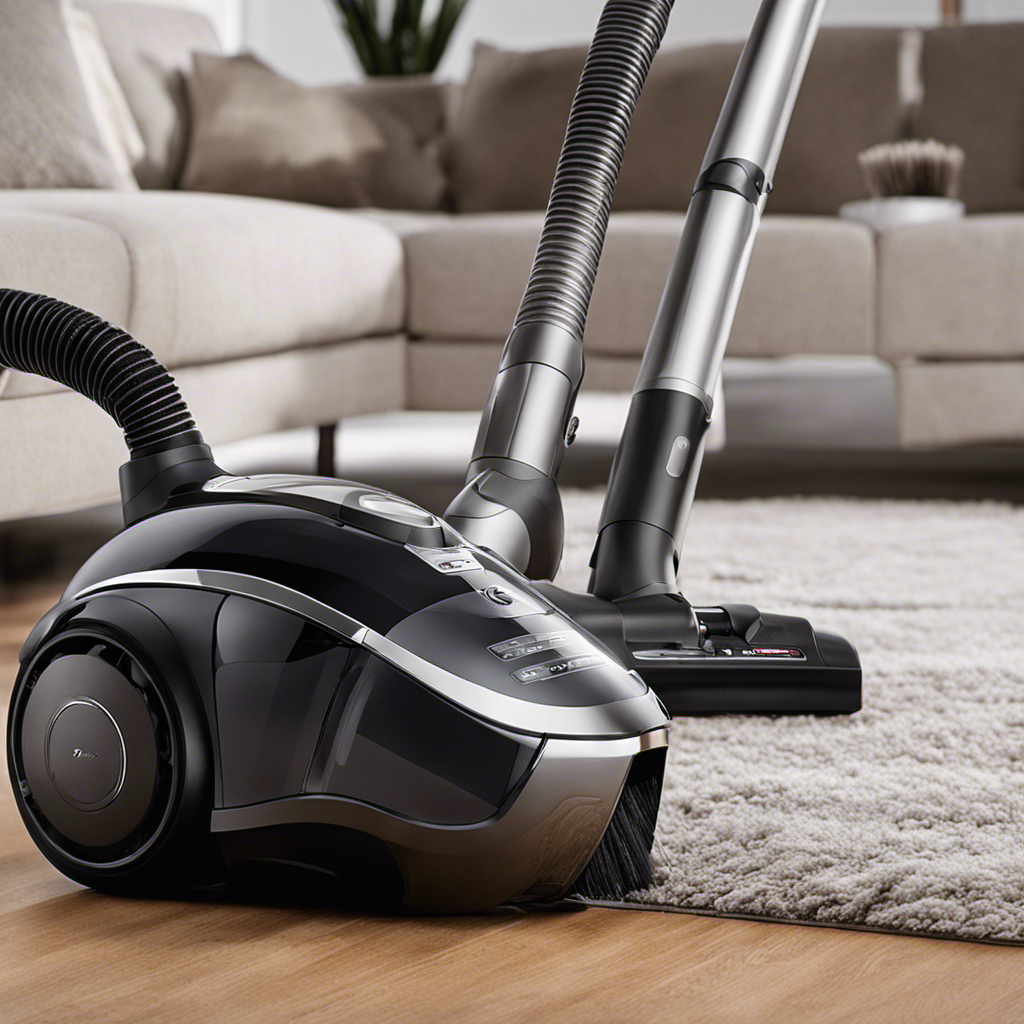
 Vacuums for Pet Hair Removal3 months ago
Vacuums for Pet Hair Removal3 months agoWhat Is Different About a Pet Hair Vacuum
-

 Guides & FAQs2 weeks ago
Guides & FAQs2 weeks agoLocal Resident Raves About Amazing Service
-
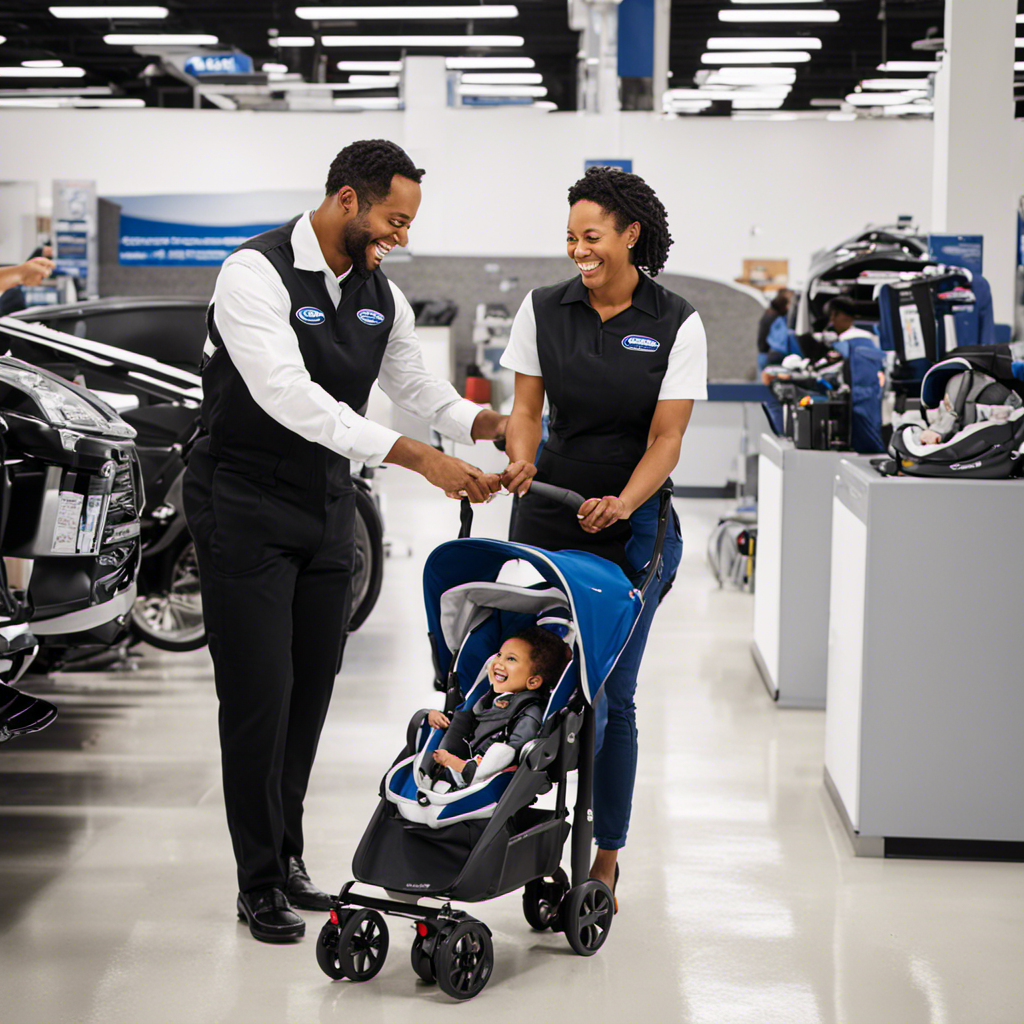
 Guides & FAQs2 weeks ago
Guides & FAQs2 weeks agoLocal Customer Raves About Graco’s Excellent Service
-
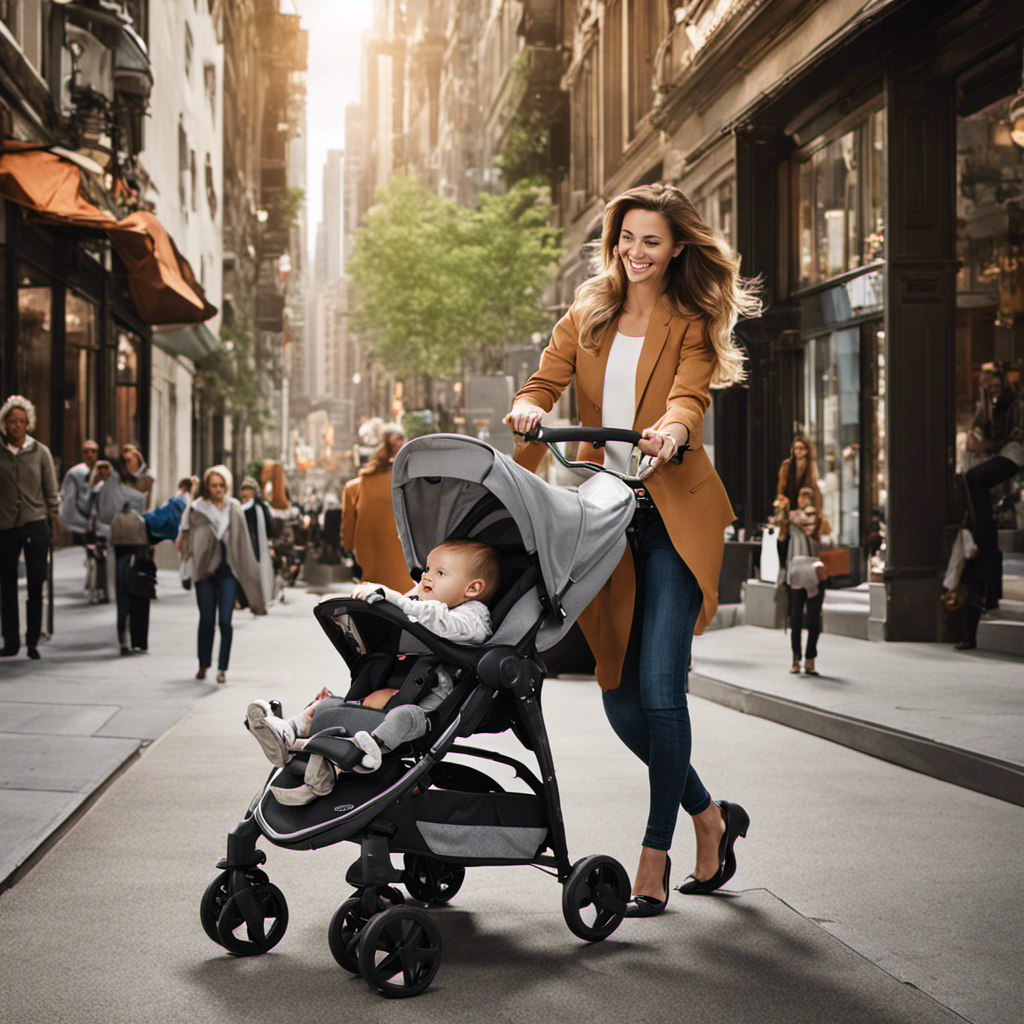
 Guides & FAQs2 weeks ago
Guides & FAQs2 weeks agoThrilled Customer Raves About Graco’s Outstanding Products
-

 Vacuums for Pet Hair Removal3 months ago
Vacuums for Pet Hair Removal3 months agoWhat Is Best Vacuum for Pet Hair
-

 Guides & FAQs2 weeks ago
Guides & FAQs2 weeks agoSydney Customer Raves About Amazing Paint Experience
-
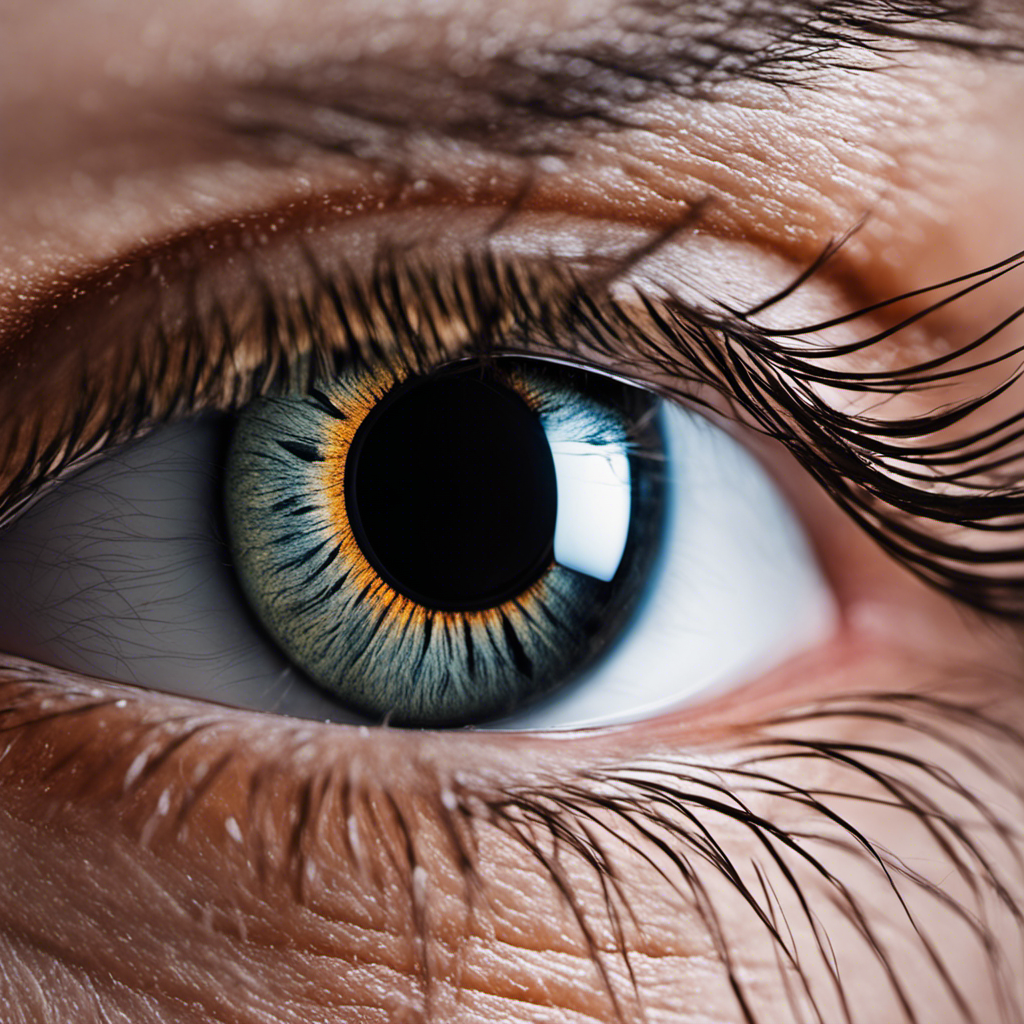
 Guides & FAQs2 weeks ago
Guides & FAQs2 weeks agoPet Hair Under Contact Lense, What to Do







